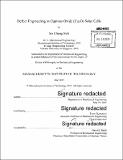| dc.contributor.advisor | Tonio Buonassisi. | en_US |
| dc.contributor.author | Siah, Sin Cheng | en_US |
| dc.contributor.other | Massachusetts Institute of Technology. Department of Mechanical Engineering. | en_US |
| dc.date.accessioned | 2015-12-03T20:56:11Z | |
| dc.date.available | 2015-12-03T20:56:11Z | |
| dc.date.copyright | 2015 | en_US |
| dc.date.issued | 2015 | en_US |
| dc.identifier.uri | http://hdl.handle.net/1721.1/100143 | |
| dc.description | Thesis: Ph. D., Massachusetts Institute of Technology, Department of Mechanical Engineering, 2015. | en_US |
| dc.description | Cataloged from PDF version of thesis. | en_US |
| dc.description | Includes bibliographical references (pages 105-109). | en_US |
| dc.description.abstract | This thesis is focused on the development of a cuprous oxide (Cu₂O) thin-film (TF) solar cell that is fabricated by manufacturing-friendly methods such as electro-deposition, sputtering and atomic layer deposition. Due to its bandgap of close to 2 eV, it has the potential of being applied as top cell in a tandem configuration. Firstly, I perform bottom-up cost and price analysis to investigate the economic feasibility of TF and c-Si based tandem photovoltaic modules. Next, I investigate the formation of good ohmic back contacts on Cu₂O absorber layer and demonstrate that low contact resistivity can be achieved with a variety of metals on heavily doped Cu₂O films by forming a tunnel junction. Then, I apply synchrotron-based X-ray absorption spectroscopy (XAS) to characterize two front contact buffer materials: amorphous Zn-Sn-O (a-ZTO) and Sndoped Ga₂O₃. I elucidate a fundamental loss mechanism in the amorphous Zn-Sn-O (a-ZTO) electron-blocking layer that has origin in local structural disorder and establish the structure-process- property relationship of a-ZTO so that the front buffer layer can be optimized for photovoltaics. Then, I investigate the doping mechanism of Sn dopant atoms in TFs and single crystalline Ga₂O₃:Sn by revealing the doping mechanism so that Ga₂O₃:Sn can be optimized for photovoltaics. Lastly. I apply bulk defect engineering to manipulate the intrinsic point defect structure of Cu₂O towards improved device performance. The key results will inform the processing conditions for improving mobility and minority carrier lifetime in Cu₂O. Keywords - Earth-abundant, thin-film solar cells, tandem, defect engineering, cost modeling, synchrotron. | en_US |
| dc.description.statementofresponsibility | by Sin Cheng Siah. | en_US |
| dc.format.extent | 109 pages | en_US |
| dc.language.iso | eng | en_US |
| dc.publisher | Massachusetts Institute of Technology | en_US |
| dc.rights | M.I.T. theses are protected by copyright. They may be viewed from this source for any purpose, but reproduction or distribution in any format is prohibited without written permission. See provided URL for inquiries about permission. | en_US |
| dc.rights.uri | http://dspace.mit.edu/handle/1721.1/7582 | en_US |
| dc.subject | Mechanical Engineering. | en_US |
| dc.title | Defect Engineering in Cuprous Oxide (Cu₂O) Solar Cells | en_US |
| dc.type | Thesis | en_US |
| dc.description.degree | Ph. D. | en_US |
| dc.contributor.department | Massachusetts Institute of Technology. Department of Mechanical Engineering | |
| dc.identifier.oclc | 930146916 | en_US |
